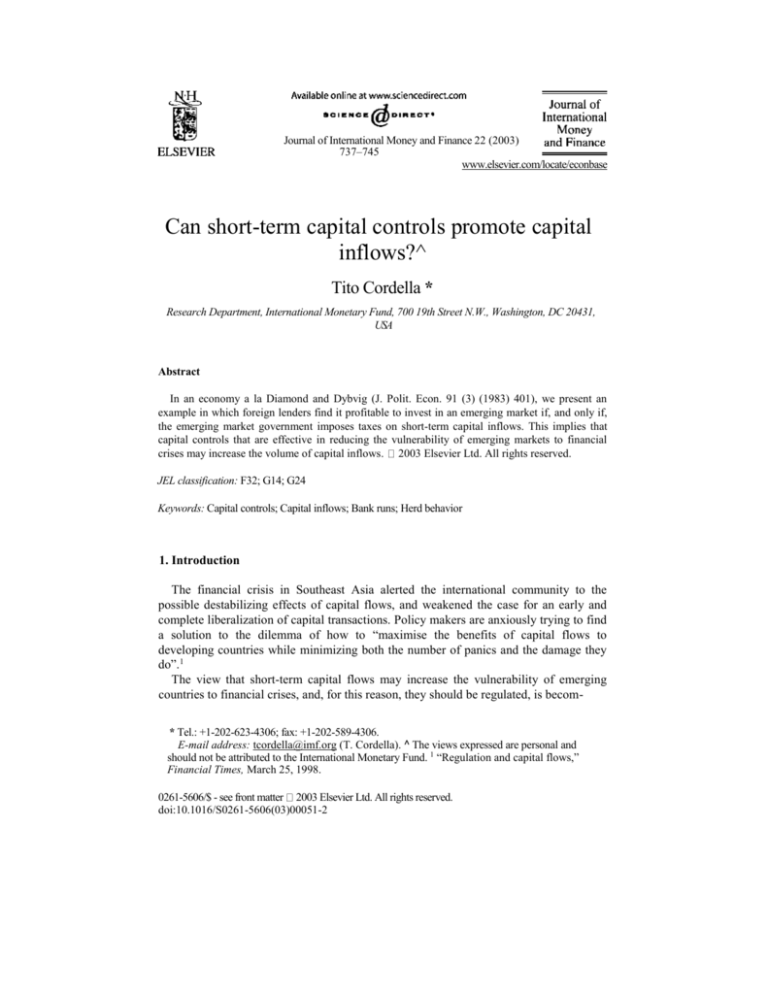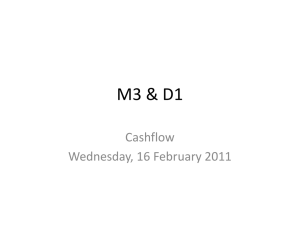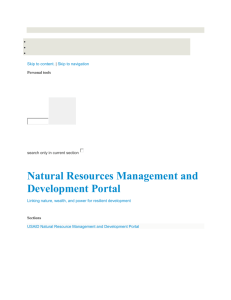
Journal of International Money and Finance 22 (2003)
737–745
www.elsevier.com/locate/econbase
Can short-term capital controls promote capital
inflows?^
Tito Cordella *
Research Department, International Monetary Fund, 700 19th Street N.W., Washington, DC 20431,
USA
Abstract
In an economy a la Diamond and Dybvig (J. Polit. Econ. 91 (3) (1983) 401), we present an
example in which foreign lenders find it profitable to invest in an emerging market if, and only if,
the emerging market government imposes taxes on short-term capital inflows. This implies that
capital controls that are effective in reducing the vulnerability of emerging markets to financial
crises may increase the volume of capital inflows. 2003 Elsevier Ltd. All rights reserved.
JEL classification: F32; G14; G24
Keywords: Capital controls; Capital inflows; Bank runs; Herd behavior
1. Introduction
The financial crisis in Southeast Asia alerted the international community to the
possible destabilizing effects of capital flows, and weakened the case for an early and
complete liberalization of capital transactions. Policy makers are anxiously trying to find
a solution to the dilemma of how to “maximise the benefits of capital flows to
developing countries while minimizing both the number of panics and the damage they
do”.1
The view that short-term capital flows may increase the vulnerability of emerging
countries to financial crises, and, for this reason, they should be regulated, is becom* Tel.: +1-202-623-4306; fax: +1-202-589-4306.
E-mail address: tcordella@imf.org (T. Cordella). ^ The views expressed are personal and
should not be attributed to the International Monetary Fund. 1 “Regulation and capital flows,”
Financial Times, March 25, 1998.
0261-5606/$ - see front matter 2003 Elsevier Ltd. All rights reserved.
doi:10.1016/S0261-5606(03)00051-2
738
T. Cordella / Journal of International Money and Finance 22 (2003) 737–745
ing increasingly popular. For example, Stiglitz suggested that emerging markets
should follow the Chilean example, and impose controls on short-term speculative
capital flows.2 In fact, according to the then chief economist of the World Bank,
“Even critics of the Chilean system acknowledge that the reserve requirement has
significantly lengthened the maturity composition of capital inflows to Chile. This
[…] may be the reason that Chile has been relatively unaffected by recent financial crises.”3
Those who oppose capital controls stress that “the effectiveness of Chile’s capital
controls is mixed. While the composition of capital inflows has been altered in favor
of longer term flows, the goal of reducing the total volume of funds entering the
country has not been achieved. Once the costs of distorting financial transactions
are added to the scheme ineffectiveness, the case for Chile’s capital controls is considerably weakened” (Edwards, 1998, emphasis added). But is this argument correct?
Should we really expect that (short-term) capital controls that reduce the vulnerability
of an emerging market to financial crises reduce the total volume of funds entering
the country?
In this paper, we will attempt to answer this question with the help of a simple
model a` la Diamond and Dybvig (1983) in which foreign investors facing uncertainty
about their liquidity needs have to decide whether to invest in an emerging market.
We show that a tax on short-term capital inflows can prevent bank runs, and through
this channel, it can increase the expected returns of investing in emerging markets.
This in turn implies that there is no reason to measure the effectiveness of (shortterm) capital controls according to their ability to reduce the volume of foreign
investments.4 In fact, capital controls that are successful in reducing the vulnerability
of an emerging market to financial crises can indeed increase the volume of capital
inflows. Accordingly, the empirical findings suggesting the ineffectiveness of capital
controls in reducing the total volume of capital flows in emerging markets5 do not
refute, and may instead corroborate, the view that short-term capital controls can be
effective instruments in reducing the vulnerability of such markets to financial crises.
2. The example
Assuming there are three periods, 0, 1, and 2, we borrow from Postlewaite and
Vives (1987) the following constant return to scale technology: for each unit invested
2
Since 1991, the Chilian law required that a fixed percentage of all non-direct foreign investment
entering the country be deposited in an unremunerated account at the central bank for 1 year. The percent
age was originally fixed at 20%, increased to 30% in 1992, reduced to 10% in June 1998, and set to zero
since September 1998. This system is equivalent to the imposition of a tax on capital inflows inversely
proportional to the length of stay of the inflow.
3
Stiglitz (1998).
4
Of course, this statement is only valid when (as in this paper) we do not consider situations in which
capital controls are imposed to limit the volume of capital inflows and thus to avoid an excessive appreci
ation of the exchange rate.
5
See for instance Valdes and Soto (1996) and Cardoso and Laurens (1998) in the case of Chile, and
Cardoso and Goldfajn (1998) for a discussion of the more controversial case of Brazil.
T. Cordella / Journal of International Money and Finance 22 (2003) 737–745
739
in the “emerging market” in period 0, a units are available in period 1, and /3 units in
period 2; for each unit left in period 1 of some amount invested in period 0, /3/a units are
available in period 2. The parameters of the model satisfy the following restrictions:
1 < a < 1< 0 < a 2 .
2
2a— 1
(1)
Note that in our framework investment is profitable only if the production process is
carried out through the two periods. If, instead, it is interrupted in period 1, the returns on
the investment are negative (a < 1).
Assume also that there are two foreign investors, i= 1, 2, endowed with one unit of
capital in period 0 facing a probability p1 (resp. p2) of lasting one (resp. two) period(s),
that is, of being “early,” or “late consumers”. At the beginning of period 1, each investor
receives a signal sieSi, Si = {si 1,si 2}, indicating his life span. We denote by pi , j the (ex
ante) probability that investor i receives signal i, when investor j receives signal j, with i,
j = 1, 2, and we suppose that the investors are identical, as of period 0, that is, pij = pji.
We further assume that the signals are observed by both agents, but cannot be used in a
court of law to enforce state-contingent contracts.6
Investor i has a linear utility function on aggregate consumption, x,
Ui (x) = 2J xi ,
(2)
i=1
with T denoting the number of periods he will live, and xi his consumption in period i.
The investors are risk neutral, maximize expected utility, and invest in the emerging
market if, and only if, the expected returns of the investment are positive, or, E(x) > 1.
The investment in the emerging market should be intermediated by a domestic
financial institution, the “bank,” that offers the following deposit contract: if an investor
withdraws his deposit in period 1, he does not earn any interest, 7 while, if he withdraws
in period 2, he receives a share of profits proportional to his deposit. In our economy, if
both investors withdraw their deposits in period 1, the bank becomes insolvent and goes
bankrupt. In this case, all assets are distributed proportional to withdrawal demands.
The emerging market government may impose capital controls in the form of taxes
that are inversely proportional to the length of stay of the inflow. In particular, we
assume that a fraction t, te. [0,1], of foreign deposits is transferred to an unremuner-
6
In other words, we assume that the bank cannot offer contracts that discriminate, in period 1, between
early and late consumers. Note that this apparently heroic assumption would trivially hold in an economy
in which the agents’ type is private information. Here, we introduced it for the sake of simplicity, and
knowing that if signals were private information our results would a fortiori hold (see Section 3).
7
Note that, since we implicitly normalize foreign interest rates to zero, we do not assume a penalty
for early withdrawals here.
740
T. Cordella / Journal of International Money and Finance 22 (2003) 737–745
ated government account at the moment of the investment (that is, in period 0). If foreign
investors withdraw from the country in period 1, they lose this amount t. If instead they
stay until period 2, they will fully recover it, albeit without interest. 8
If, in period 0, both investors decide to enter the emerging market, the strategy for
investor i is a function ai :S1 × S 2—>A, with A = {a1,a2}, and ai denoting withdrawal in
period i. If the foreign investors deposit in the bank at period 0, the returns they receive
in period 1, or 2, depend on their withdrawal decisions. In particular, should they both
decide to withdraw in period 1, the bank will go bankrupt and they will receive their
share (half) of the total assets, 2a(1 —t), of the bank at period 1. If, instead, both
investors withdraw in period 2, they will both receive their share (half) of the realized
returns, 2/3(1 — t), and they will be reimbursed by the government of the tax,
withholding t. The more interesting case is the one in which one depositor withdraws in
period 1, while the other does not. In this case, the “early consumer” will get the total
amount of his initial deposit (net of the tax), while the other will receive for each of the
remaining 2(1 — t)a— (1 — t) units available in period 1, fi/a units in period 2. He will
also be reimbursed of the tax. The payoffs are summarized in Table 1.
Let us define
a2-2ap + ft
=a
2-
2a/3 + /3 + a~
One can immediately verify that: (i) for te [0,f), both investors withdraw in period 1, if
either investor is of type 1. This in turn implies that when a late consumer faces an early
consumer, in period 1, he will withdraw his money from the emerging market, not for
consumption purposes, but because the other investor withdraws: we are in the presence
of “herd behavior;” (ii) if, instead, t>C, not to withdraw in period 1 is a dominant
strategy for an agent of type 2. This in turn implies that:
Table 1
Payoffs
Agent1
a1
a2
8
Agent 2
a1
a2
(1-t)a; (1-t)a
(2a—1)(1 — t)
(1 —t);------------------ p + t
(2a—1)(1 — t) -- (1 — t)j3+t; (1 — t)j3 + t
---------------- p + t; (1 — t)
In order for our result to hold, it is sufficient to assume that the tax is inversely proportional to the length of
the stay, i.e., that it discriminates between short- and long-term capital inflows. The assumption of a complete
tax rebate (in period 2) is done for the sake of simplicity, and does not affect the qualitative results of the paper.
T. Cordella / Journal of International Money and Finance 22 (2003) 737–745
741
Remark 1. Taxes on short-term capital inflows may prevent bank runs. If t > f, agents
do not withdraw their money unless they are early consumers.
The intuition behind the above result is the following: in the absence of a tax on
capital inflows, the withdrawal of an early consumer forces the bank to recall part of its
loans. This reduces the expected returns (in period 2) of the investment, from
b to --------- b, which, under Assumption (1), is strictly smaller than a. In this case,
late consumers would always follow early consumers in withdrawing their deposit from
the bank. Here, herd behavior is perfectly rational, and it is the result of the strategic
interaction between agents. The introduction of a tax on short-term capital inflows
reduces the returns associated with herd behavior, both by decreasing the payoff
associated with an early withdrawal, and by increasing the returns associated with
keeping the deposit in the bank9 until period 2. Note that df/da < 0, and df /db < 0. This
implies that higher bank liquidity (higher values of a), or higher capital productivity
(higher values ofb), complement Chilean-style controls in the sense that a lower tax is
needed to “stabilize” the banking system.
The (pure strategy) Nash equilibria in the different states of nature for te[0,f) and t>f
are summarized in Table 2.
The imposition of a sufficiently large tax (t > f) on capital inflows, preventing bank
runs, may thus increase investors’ expected returns. In our framework, such a tax, by
deterring the bank from disinvesting all its assets when only one of the investors is an
early consumer, increases investors’ returns when they receive different signals. From
the investors’ point of view, these (expected) gains should be weighted against the losses
induced by the tax when both investors receive the same signal, and thus they are both
early or late consumers. In particular, it can be seen that:
Remark 2. If the signals that the investors receive are perfectly (negatively) correlated
(p11 = p22 = 0, p12 = p 21 = 1/2), there exists a non-empty interval of tfor which expected
returns are higher in the presence of a positive tax on capital inflows.
Table 2
Nash equilibria
Agent1
Agent 2
t<f
s1
s2
9
t>f
s1
s2
s1
s2
a1;a1
a1;a1
a1;a1
a2;a2
a1;a1
a2;a1
a1;a2
a2;a2
/(2a—1)(1 — t)
\..
In fact, we find that 9(1 — t)a/dt < 0, and, from (1), 91 ---------------------- b + t \/dt > 0.
742
T. Cordella / Journal of International Money and Finance 22 (2003) 737–745
Proof. The expected returns of investor i, in the absence of the tax, are given by
E(xoi) = (p12 + p21)a = a,
(3)
while in the presence of a tax t > f, they are given by
a + (1 —t)(2a—1)b
E(xti ) =--------------------------- .
(4)
Furthermore, from Eqs. (3) and (4), we can determine that
E(xti) — E(xoi) > 0ot <
= t.
(5)
To complete the proof, it is enough to show that the interval [t*,t˜ ] is non-empty. The
reader may easily verify thatb > 1>a=>[f,˜t] ^ 0.B
It is important to mention that, when the signals that the investors receive are
negatively correlated, the policy of imposing a tax t = C maximizes investors’ returns.
Furthermore, since such a tax makes both foreign investors and the emerging market
government strictly better off, it Pareto dominates free capital mobility. By imposing a
tax f, the government prevents runs, and by doing so, it reduces the cost associated with
withdrawing from the emerging market.10 The basic intuition behind our result is the
following: a large international bank is more prone to invest in any particular emerging
market if it knows that the liquidity conditions in that market would not create obstacles
to its eventual disinvestment.
From Remark 2, and by continuity, the reader may easily infer that if the signals are
sufficiently negatively correlated, it is always possible to increase foreign investor
returns by imposing a tax on short-term capital inflows. It is also possible to envisage
situations in which foreign investors find it profitable to invest in the emerging market
only in the presence of taxes on short-term capital inflows. This can well be the case
even if signals are uncorrelated.
As an example of the above statement, let a = 0.55, b = 2.33, p11 = p12 = p21 = p22
=1/4. The reader may easily verify, that, in the absence of a tax on capital inflows,
E(xoi)~0.99, so that the utility associated with the consumption of the initial endowment
is higher than that associated with the investment in the emerging market. Consider now
a tax t= C —0.113. It yields E(xoi)~1.01. This, in turn, implies that:
Remark 3. Taxes on short-term capital inflows may increase gross investments in
emerging markets.
3. Concluding remarks
Our example suggests that taxes on short-term capital inflows, by avoiding rational
panics, can improve the expected returns of investments in an emerging market, and thus
increase the total volume of funds entering the country. For expositional simA tax t de facto subsidizes late consumers at the expense of early consumers.
∗
T. Cordella / Journal of International Money and Finance 22 (2003) 737–745
743
plicity, we dealt with a very stylized framework, with seemingly heroic assumptions
about the informational structure and the number of players. The reader may wonder
whether our conclusions rely heavily on these assumptions.
Let us first relax the assumption that the signals are observable by both agents, and
consider an economy in which agent type is private information. Asymmetric
information, by increasing the vulnerability of the financial system to runs, also increases
the effectiveness of short-term capital controls. Suppose that each agent does not know
whether the other agent is an early or a late consumer. In this case, a tax on short-term
capital inflows will not only avoid herd behavior when one of the agents is of type 1 and
the other of type 2, but also stem the possibility of bank runs when both agents are late
consumers, but each of them assigns a positive probability that the other one is an early
consumer, as in Postlewaite and Vives (1987). In order to check whether our results are
robust to different assumptions on the number of players and the technology, we
simulated the effect of the Chilean-style controls in Goldfajn and Valdes, 1997 with a
continuum of agents that face productivity shocks in period 1. Preliminary findings
confirm that the same basic intuition of this model holds in this richer framework. Taxes
on short-term capital controls reduce the probability of bank runs, and, through this
channel, they can increase the volume of foreign investments.
The fact that the insights that one can derive from our simple model are quite general
should not surprise the reader. The reason why a tax on capital inflows can increase the
volume of inflows follows directly from basic principles: if the supply of capital to
emerging markets depends on the vulnerability of these markets to financial crises,
capital controls that make these markets less vulnerable should, ceteris paribus, increase
the supply of capital. Of course, the ceteris paribus assumption cannot be made here.
Capital controls are distortive: they reduce investors’ long-run returns, and increase the
degree of irreversibility of investment decisions.11 These are the costs that should be
weighted against the gains induced by a safer financial environment. Taxes on short-term
capital inflows may thus either increase or decrease the volume of capital flows
according to which of the two forces prevails.12
Our stylized framework cannot say much on whether the overall effect of the
imposition of short-term capital controls should be that of increasing or decreasing the
volume of capital inflows. The model only rules out the fact that the imposition of capital
controls necessarily reduces capital inflows. The Chilean experience seems supportive of
this view. In fact, as De Gregorio et al. (2000) suggest, there is no evidence that the
aggregate volume of capital inflows in Chile has decreased because of the imposition of
short-term capital controls; the latter seems to have only affected the composition of
capital inflows. Indeed, the fact that the decrease in short-term inflows appears to be
completely compensated by an increase in longer term inflows
11
See Bartolini and Drazen (1997), and Laban and Larra´ın (1997) for models in which a more liberal
policy on capital outflows increases net capital inflows, either giving a signal of the government’s future
policies, or by making the investment decisions less irreversible.
12
This can partly explain the fact that Chile continued modifying the percentage of unremunerated
reserve requirements according to the domestic and international economic situation.
744
T. Cordella / Journal of International Money and Finance 22 (2003) 737–745
is consistent with the view that the imposition of short-term capital controls lowered
Chile’s country risk premium, and via this channel, it attracted new foreign investments.
In fact, had capital controls not reduced “the probability of a banking or a balance of
payment crisis (driven by either fundamentals or sunspots),”13 the effect of the
introduction of a tax on short-term capital inflows should have been that of reducing the
overall volume of capital inflows. This is of course, unless one assumes that either the
imposition of short-term capital controls only led to a relabeling of flows, or that the total
supply of foreign capital to Chile is fixed, and thus totally inelastic to taxes.
To conclude, it is worth mentioning that, in this paper, we carefully avoided raising
the normative question of whether, and under which circumstances, the imposition of
short-term capital controls can be welfare improving. Our model is a partial equilibrium
one, and as such is not suited to address welfare questions. This said, the results of our
analysis may have important welfare implications. In particular, the fact that properly
designed controls on short-term capital inflows may reduce a country’s risk premium
implies that they may stimulate economic activity and thus foster growth. This, of
course, is more likely to be the case in those emerging markets that are more prone to
sudden withdrawals of highly volatile foreign capital. In countries that are less likely to
suffer from abrupt changes in market sentiments, for instance countries that are
recipients of substantial FDI flows, the distortionary costs associated with capital
controls are more likely to dominate the welfare gains due to increased stability.
Acknowledgment
I would like to thank Giovanni Dell’Ariccia, Edward Frydl, Pietro Garibaldi, Ilan
Goldfajn, Haizhou Huang, Eduardo Levy Yeyati, Gian Maria Milesi-Ferretti, Luca Ricci
and an anonymous referee for their helpful comments.
References
Bartolini, L., Drazen, A., 1997. Capital-account liberalization as a signal. American Economic Review
87 (1), 138-154. Cardoso, I., Goldfajn, E., 1998. Capital flows to Brazil: the endogeneity of capital controls.
IMF Staff
Papers 45 (1), 161-202. Cardoso, J., Laurens, B., 1998. Managing Capital Flows: Lessons from the
Experience of Chile. IMF
Working Paper WP/98/168. De Gregorio, J., Edwards, S., Valdes, R., 2000. Controls on capital inflows: do
they work? Journal of
Development Economics 63 (1), 59-83. Diamond, D., Dybvig, P., 1983. Bank runs, deposit insurance, and
liquidity. Journal of Political Economy
91 (3), 401-419.
De Gregorio et al. (2000), p. 77.
T. Cordella / Journal of International Money and Finance 22 (2003) 737–745
745
Edwards, S., 1998. The Americas: capital controls are not the reason for Chile’s success. Wall Street
Journal April 3. Goldfajn, I., Valdes, R., 1997. Capital Flows and the Twin Crises: the Role of Liquidity.
IMF Working
Paper WP/97/87. Laban, R., Larra´ın, F., 1997. Can a liberalization of capital outflows increase net capital
inflows? Journal
of International Money and Finance 16 (3), 415-431. Postlewaite, A., Vives, X., 1987. Bank runs as an
equilibrium phenomenon. Journal of Political Economy
95 (3), 485-491. Stiglitz, J., 1998. Boats, planes and capital flows. Financial Times March 25. Valdes, S.,
Soto, M., 1996. ¿Es el control selectivo de capitales efectivo en Chile? Su efecto sobre el
tipo de cambio real. Cuadernos de Economia 98, 77-108.








